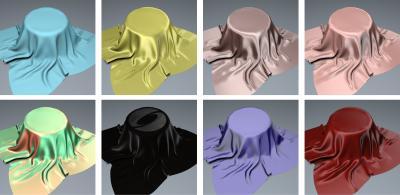Computer scientists at the University of California, San Diego, have developed a new modelto simulate with unprecedented accuracy on the computer the way cloth and light interact.The new model can be used in animated movies and in video games to make cloth look more realistic.
Existing models are either too simplistic and produce unrealistic results; or too complexand costly for practical use. Researchers presented their findings at the SIGGRAPH 2013conference held July 21 to 25 in Anaheim, Calif.
"Not only is our model easy to use, it is also more powerful than existing models," said ImanSadeghi, who developed the model while working on his Ph.D. in the Department of ComputerScience and Engineering at UC San Diego. He currently works for Google in Los Angeles, after earning his Ph.D. in 2011.
"The model solves the long standing problem of rendering cloth," said Sadeghi's Ph.D. advisorHenrik Wann Jensen, who earned an Academy Award in 2004 for research that brought lifelike skin to animated characters and was later used in many Hollywood block busters, including"Lord of the Rings." "Cloth in movies and games often looks wrong, and this model is the first practical way of controlling the appearance of most types of cloth in a realistic way."
The model is based on a novel approach that simulates the interaction of light with cloth bysimulating how each thread scatters light. The model then uses that information based on thefabric's weaving pattern. "It essentially treats the fabric as a mesh of interwoven microcylinders,which scatter light the same way as hair, but are oriented at 90 degrees from each other," Sadeghi said.
Sadeghi is an expert on the subject of simulating light interacting with hair. While a Ph.D.student in Jensen's research group, he developed a model that does just that and that was later used in Disney's "Tangled," a retelling of the Brothers Grimm fairy taleRapunzel. The animated movie's main character sported 70 feet of simulated blond hair.
"In addition to faithfully reproducing the appearance of existing fabrics, our model can act asa framework to visualize what new fabrics would look like. We can simulate any combinationof weaving pattern and thread types," said Oleg Bisker, who co-authored the paper as part of his master's thesis on measuring and modeling light scattering from threads.

From left to right are: Silk crepe de chine, linen plain, silk shot fabric, velvet and polyester satin charmeuse. At the far right are reference photographs for three of the fabrics. The model is based on a novel approach that simulates the interaction of light with cloth by simulating how each thread scatters light. The model then uses that information based on the fabric's weaving pattern.
(Photo Credit: Iman Sadeghi et. al., Jacobs School of Engineering/UC San Diego)
Sadeghi and Bisker presented the work at SIGGRAPH and fielded many questions fromresearchers in the game and movie industries. "We expect that our model will be used in manyproduction pipelines soon," Sadeghi added.
Sadeghi and colleagues used the model to simulate the appearance of a very complex fabric forthe first time—more specifically a polyester satin charmeuse. That fabric is particularly tricky torender, because of its unusual weaving pattern, which gives it a different appearance dependingon what direction and what side it is observed from. For example, in one direction, the satincharmeuse has three mirror-like highlights on the front side of the fabric and four on the back.
To gain a deeper understanding, Sadeghi and colleagues took photographs of fabrics and even measured the scattering properties of single threads. The researchers had their "a-ha!" momentfor developing the model while looking at the fabric's weaving patterns under a microscope.That's when they realized that these patterns accounted for the way the light scattered on thefabrics, creating distinct highlights and overall appearance.
In their SIGGRAPH paper, the authors also simulated other types of fabric like plain linen and asilk crepe de chine. Their goal was to demonstrate the model's ability to handle different typesof thread and an unlimited variety of weaving patterns. The only other models that may be ableto produce similar results to the one Sadeghi and colleagues developed put fabrics through amicro-CT-scan, an expensive and time-consuming procedure.
The other computer scientist working on the paper was Joachim De Deken, a master'sstudent, who took measurements of fabrics.

From left to right are: Top row: linen plain, silk crepe de chine, front side of polyester satin charmeuse fabric, back side of the polyester satin charmeuse. Bottom row: silk shot fabric, velvet, an imaginary fabric made of silk and polyester threads with a shantung weaving pattern, and an imaginary fabric with asymmetric, mirror like peaks. The model is based on a novel approach that simulates the interaction of light with cloth by simulating how each thread scatters light. The model then uses that information based on the fabric's weaving pattern.
(Photo Credit: Iman Sadeghi, et. al/Jacobs School of Engineering/UC San Diego)